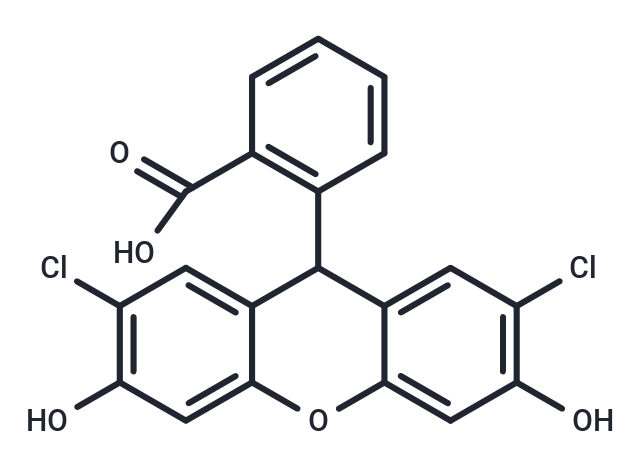Shopping Cart
- Remove All
 Your shopping cart is currently empty
Your shopping cart is currently empty

2,7-Dichlorodihydrofluorescein (DCFH) is a non-fluorescent probe that is oxidized by intracellular reactive oxygen species (ROS) to produce the highly fluorescent 2',7'-Dichlorofluorescein (DCF).DCFH is commonly used to assay the intracellular level of ROS, to detect ROS production and to analyze oxidative stress.

| Pack Size | Price | Availability | Quantity |
|---|---|---|---|
| 2 mg | $35 | In Stock | |
| 5 mg | $56 | In Stock | |
| 10 mg | $89 | In Stock | |
| 25 mg | $159 | In Stock | |
| 50 mg | $233 | In Stock |
| Description | 2,7-Dichlorodihydrofluorescein (DCFH) is a non-fluorescent probe that is oxidized by intracellular reactive oxygen species (ROS) to produce the highly fluorescent 2',7'-Dichlorofluorescein (DCF).DCFH is commonly used to assay the intracellular level of ROS, to detect ROS production and to analyze oxidative stress. |
| In vitro | Instructions I. Solution preparation 1. Preparation of stock solution: Dissolve 4.85 mg 2,7-Dichlorodihydrofluorescein in 1 mL dimethyl sulfoxide (DMSO) to make a 10 mM stock solution. 2. Preparation of working solution: Dilute the stock solution to a 10 μM working solution with pre-warmed DMEM before adding it to the wells. II. Operation steps 1. Cell seeding Inoculate 2 × 10^5 HCT116 colorectal cancer cells per well in a 24-well plate and maintain the cells in Dulbecco's modified Eagle's medium (DMEM) at 37 °C overnight. 2. 2,7-Dichlorodihydrofluorescein staining 1) Remove the medium containing the drug and wash once with DMEM. 2) Add 500 μL of 2,7-Dichlorodihydrofluorescein working solution to each well and incubate at 37 °C for 30 minutes. 3) Remove the 2,7-Dichlorodihydrofluorescein working solution, wash once with DMEM and twice with 1× phosphate-buffered saline (PBS). 4) Add 500 μL of 1× PBS to each well. 3. Imaging acquisition and intensity measurement 1) Take representative fluorescence images for each well using the green fluorescent protein (GFP) channel on a fluorescence microscope. 2) After taking the image, remove the PBS and add 200 μL of radioimmunoprecipitation assay (RIPA) buffer to each well. 3) Incubate on ice for 5 minutes, then collect the cell lysate into a 1.5 mL tube. 4) Centrifuge at 21,130 × g for 10 minutes at 4 °C. 5) Transfer 100 μL of supernatant to a black 96-well plate and measure the fluorescence intensity using a fluorescence microplate reader at an excitation wavelength of 485 nm and an emission wavelength of 530 nm. 6) Transfer 1 μL of supernatant to a clear 96-well plate containing 100 μL of 1× protein assay solution to measure protein concentration using Bradford assay. 7) Normalize the fluorescence intensity with the protein concentration. |
| Alias | DCFH |
| Molecular Weight | 403.21 |
| Formula | C20H12Cl2O5 |
| Cas No. | 106070-31-9 |
| Smiles | O=C(O)C=1C=CC=CC1C2C3=CC(Cl)=C(O)C=C3OC4=CC(O)=C(Cl)C=C42 |
| Storage | keep away from direct sunlight | Powder: -20°C for 3 years | In solvent: -80°C for 1 year | Shipping with blue ice. | |||||||||||||||||||||||||||||||||||
| Solubility Information | DMSO: 200 mg/mL (496.02 mM), Sonication is recommended. | |||||||||||||||||||||||||||||||||||
Solution Preparation Table | ||||||||||||||||||||||||||||||||||||
DMSO
| ||||||||||||||||||||||||||||||||||||

Copyright © 2015-2025 TargetMol Chemicals Inc. All Rights Reserved.